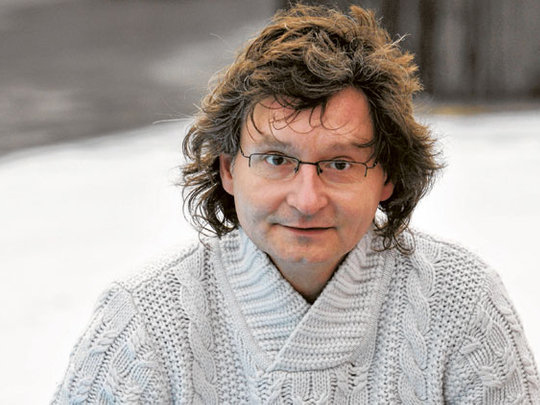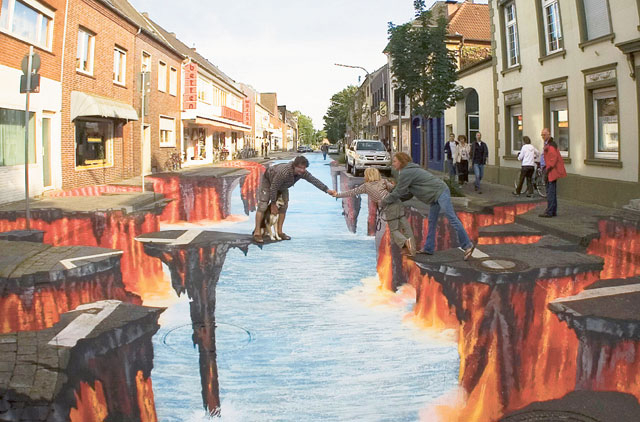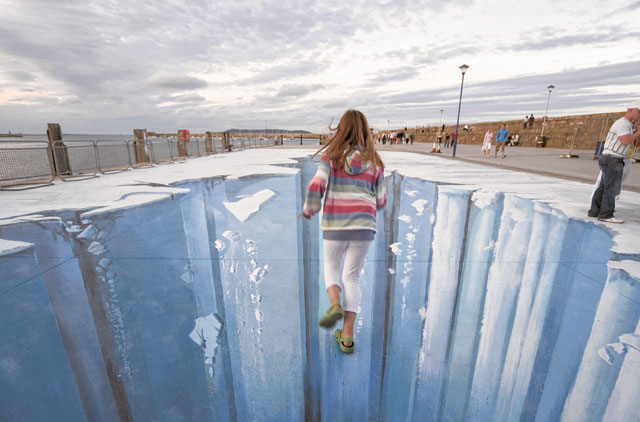
Great works of classical art are usually found painstakingly painted on canvas or monumentally crafted across the domes of cathedrals. In the late 16th century, however, itinerant (travelling) artists used whatever canvas was available — the courtyards of grand Italian cathedrals were their working surfaces.
The art form died off but 30 years ago gathered pace again and modern pavements around the world began to resemble classic masterpieces.
On his way to school in the small German city of Geldern more than 35 years ago, a young Edgar Mueller walked past a street-painting competition where copies of old masters such as Rembrandt and Caravaggio had been chalked on the pavement.
It was at this point that he fell in love with the art form and it wasn't long before he was doing it for a living.
"I was painting and sketching since I was able to hold a brush. It was therefore obvious that I entered a competition," he told Weekend Review from Germany. "I absolutely fell in love with painting on the street."
Self-taught genius
Mueller was 16 when he drew his first chalk street picture, dropping out of a course in Communication Design to pursue street painting.
He hasn't looked back since.
"I was always an autodidact, following the principle ‘Learning by doing'. I still remain loyal to the philosophy that every solution you find out yourself, you will never forget," he said.
While studying the techniques of the old masters, Mueller also joined several street-painting festivals and then started to make a living from his art. Now, he doesn't paint conventionally. "Street painting turned out to be my profession and my language to talk to people. I never do ‘other' paintings any more," he said.
The early street painters would often paint images of the Madonna and hence came to be known as the "Madonnari". These images, however, were commonly two-dimensional.
Along with the resurgence of street art have come developments in techniques and methods. A third dimension is one such development.
Mueller's first contact with 3D street painting was from a client inquiry to paint a car.
He saw artist Julian Beever's paintings and was impressed by his fresh ideas. However, he says, Kurt Wenner was the first to use anamorphic illusion in street paintings, "his skill and drawing technique[s] are perfect and look like a renaissance master's work".
Wenner transformed classical Italian architecture into this new form of art in 1982, taking masterpieces and placing them firmly underfoot.
It was after a National Geographic documentary, Masterpieces in Chalk, was made about him and his artwork that he was firmly placed in the global spotlight. Wenner has also won a number of awards for his art.
In the United Kingdom, Beever's trompe l'oeil work has gained him similar attention. Working on pieces since the mid-1990s, his paintings have earned him the nickname "Pavement Picasso".
One of Mueller's most challenging 3D paintings was created at the Festival of World Culture in Dun Laoghaire, Ireland, in 2008.
The Crevasse took five days to complete with the help of five assistants and spanned 250 square metres. Viewed from a single point, the painting takes on the 3D form of a huge icy crevasse, as if the pavement itself has cracked away, revealing the walls of ice below.
So why was this painting the most challenging for the artist?
"Ireland has four seasons a day. We had to fight the weather many times. Sunshine, rain and hailstorm alternated within hours. We were afraid we wouldn't make it through, but finally, and with help from many people, we did it," Mueller said.
Battling the elements is par for the course for street artists, whose outdoor activities necessitate taking the weather conditions as they come.
Rain is one of the biggest issues — with street art traditionally done in chalk, the water washes the masterpieces away.
This doesn't, however, prove a problem for Mueller. "Once a painting is done, I somehow lose interest in it. It's done and for me it is up to go for the next," he said.
From this temporary interest in a project, however, has come more permanence. The artist has stopped using chalk and is now using water-based acrylic paint for large-scale paintings. Even so, he said, "bad weather can ruin hours of work. I have to watch the sky and adapt my work process to the weather forecast. But once the paint is dry, it can stand any rain."
Rain, hail and snowstorms, however, are not the only challenge facing this new generation of street artists.
By the very nature of their canvas — a public place — passers-by tend to comment on the works of art taking form beneath their feet.
"Sometimes it gets too much for me. Too much input from people, too many questions. Fortunately, I can use people's inputs as a resource for my creativity. Often, a talk with someone or an unforeseeable event causes a change in me and my painting," Mueller said.
However, he continued, people's reactions are as varied and as colourful as his palette. Some examples of typical reactions from passers-by are: "This is awesome"; "What happens if it rains?"; "Why don't you paint on canvas and sell your art? You can be a rich person"; "Hey, painter, can you do a portrait of my girlfriend?"; "Those smearings should be banned"; "Excuse me. Would you mind answering some questions?"; and "Jesus loves you!".
Interaction with the public doesn't stop when the artwork is complete, however.
The temptation to leap on to the painting and pretending to be a part of the scene to have your picture taken is great for most who stroll past Mueller's 3D masterpieces.
While at first people might step around or over the pictures, once they see that the scenes are almost interactive, they tend to become more involved with the depictions.
Hence, his art comes alive.
The physical texture of the ground also throws up challenges for street artists, who have to adapt their art to the canvas.
Technically, there are many aspects that street artists have to stay aware of. For one, the painting style has to be adapted to the condition of the ground, Mueller said, which is challenging, as each patch of ground has its own character.
"In case the surface is very rough, it is difficult to work out the details. If it is too smooth, the physical resistance is missing," he said.
Working on such a huge project can also mean a lot of physical activity. Mueller's paintings are up to 30 metres long and he has to "walk back and forth countless times a day".
"On a project, I skip my weekly fitness programme," he said.
Through rain, shine and being closed down by authorities who forbid street art, Mueller continues. So what is next for the painter? "I would like to draw a waterfall or a glacier in the desert somewhere," he said, not directly alluding to the notion that the UAE would be a perfect setting for such a piece.
Wherever this ultimate work of art might be created, it will definitely be painted on a pavement. There is "no way" the artist is ever going to start using other surfaces, such as buildings façades, for his works.
Whatever effect his work might have, it should be lasting.
"Every artist," Mueller said, "wants to reach people and evoke feelings. But a picture that [has] already said everything on being seen once is not worth a second look."













